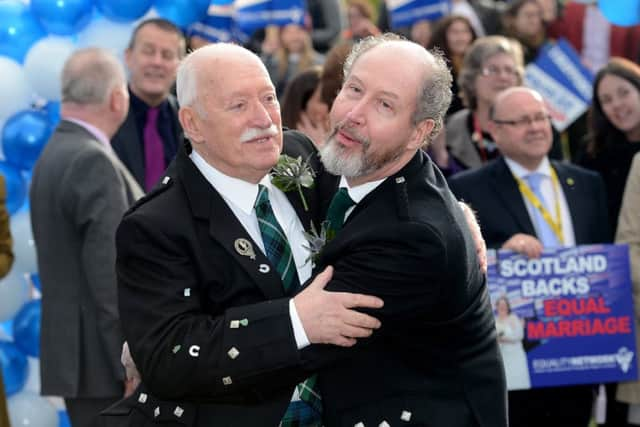Same-sex weddings act could see marriage boom


The Marriage and Civil Partnership (Scotland) Act 2014 comes into force on 16 December, 2014. The act is further demonstration of the commitment by the Scottish Government to promoting the rights of the lesbian, gay, bisexual, transgender and intersex (LGBTI) community. A practical implication of the new legislation is that the first wedding ceremonies between two people of the same sex will be able to take place on 31 December, 2014.
It would seem likely that January 2015 could see a significant number of newly married couples, both same and opposite sex, but when the confetti has been swept away, what will the institution of marriage in Scotland be after same-sex marriage becomes a reality? The answer is, probably not so very different than it is now.
Advertisement
Hide AdAdvertisement
Hide AdImportantly, however, it will be a far more inclusive institution. There will effectively be three categories of relationship recognised and regulated by the state: marriage, civil partnership and cohabitation.
Those already in a civil partnership are entitled to choose to have their partnership converted to marriage, with the date of their marriage effectively being back-dated to the date when their civil partnership was registered in Scotland. Alternatively, they can choose to retain their status as civil partners.
For transgender persons who are married or party to a civil partnership, the issuing of a gender recognition certificate no longer carries with it the requirement to divorce or dissolve the partnership. This resolves a former consequence of applying for gender recognition, which was often unintended.
One tangible benefit that the new legislation brings is to invigorate discussion of marriage, its benefits and its consequences. Marriage brings the future into very sharp focus. When planning a wedding, many aspects of the ceremony and festivities are carefully considered. What couples don’t often consider however is the way in which they would want their marriage to conclude if that becomes necessary.
A new trend in weddings is for the couple to write letters to each other, which are only to be opened in the event of their first argument. The idea is that when reading these letters, the couple will remember all of the love and understanding they had towards one another on their wedding day, and the dispute will be forgotten.
Reaching agreement regarding the personal and financial issues at the end of a marriage (a “pre-nuptial agreement”) before the ceremony might sound unromantic or a premature destruction of trust, but simply, it is very much in the same spirit as writing letters to a future self.
It allows couples to consider a kind, practical and economic way to resolve separation when they are in a place of love and trust, rather than when they are facing the hurt and turmoil that comes at the end of a relationship.
A pre-nuptial agreement can be as specific or as general as the parties wish, but it is important that both parties have the proper opportunity to take legal advice on its terms and it must be fair and reasonable at the time it is signed if it is to be upheld.
Advertisement
Hide AdAdvertisement
Hide AdThe agreement can provide protection for any property owned by the parties prior to the marriage. It can regulate whether contributions made from non-matrimonial funds should be repaid upon separation, eg if one party pays the deposit to purchase a home.
There may also be practical arrangements that parties want put in place prior to marriage. Retention of important personal possessions and ownership of beloved pets are issues, which can be regulated in a pre-nuptial agreement. Parties might opt instead to have a “post-nuptial” agreement following marriage.
Civil partners who choose not to transfer to marriage can still enter either of these types of agreement. For cohabitants, while they might never marry, in Scotland, the end of their relationship is also regulated by statute. Cohabitants are entitled to seek what amounts to financial provision from one another to redress the economic advantages and disadvantages resulting from the relationship.
They are also entitled to enter into an agreement to regulate the end of their cohabitation, rather than have a decision imposed upon them by a court.
As with pre- and post-nuptial agreements, for cohabitation, an agreement can provide the opportunity to invest in an amicable end to a relationship.
For the newlyweds of 2015 – together with the wedding album, the marriage certificate and all of the wonderful memories, why not consider an agreement that jointly secures the future? It might never be needed but it’s good to know it’s there.
• Nadine Martin is a solicitor with BLM www.blmlaw.com
SEE ALSO